Silver Beach Amusement Park History
 Page 3 of 6 Page 3 of 6 
Click photos below
for expanded views
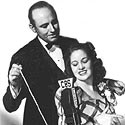
| 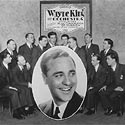
| 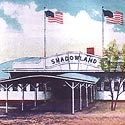
| 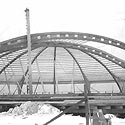
| 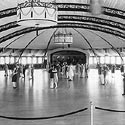
| 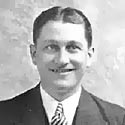
| 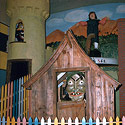
| 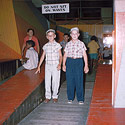
| 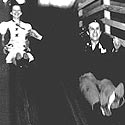
| 
| 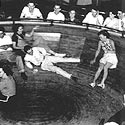
|
A new Silver Beach Amusement Park structure was built around 1917, housing a new attraction. Louis Wallace had just opened a bowling alley in South Bend, Indiana, that was rapidly becoming successful. The thought of starting the business at the beach seemed profitable, too. The park was currently operating a ten pin alley, which was similar to bowling but with smaller balls, pins and lanes. Drake decided to remove the small version of the game and replace it with the real thing. Eight bowling lanes were set up into position, as were twelve billiard tables and a soda fountain. The Twin Cities had their first bowling alley with Frank Lewis, a renowned bowler from Detroit, as its manager.1
Bowling was different in the 1920s than it is today. There were no mass-produced scoresheets, so the score was kept on blackboards behind the bowlers. In the early days at Silver Beach Amusement Park, women were not allowed to bowl or shoot pool and the only woman likely to be seen in the "man's den" was the manager's wife. There were no automatic pinsetters either, but the problem was alleviated by hiring young ambitious schoolboys to set pins. Bowling found a spot in the hearts of the people of southwestern Michigan, a couple of leagues sprang up at the park, and even major league bowlers were often at the lanes.2
While an immediate success, the bowling alley was closed in 1928 because indoor bowling proved far too warm for Michigan summers.
If the twenties were indeed "roaring", then Silver Beach Amusement Park was one of the loudest lions around. One thing happened after another in the park. The dance hall was filled to capacity nearly every weekend. And when there was no band, the couples could pay five cents a ticket and dance to organ music. When there was a band or two at the pavilion it seemed like the entire Twin Cities attended. Among the bands appearing in the dance hall were medical students, and brothers Billy and Eddie Goodhart. Stein, who played sax and clarinet, with Billy on piano and Eddie on bass horn, performed at the Silver Beach dance hall for five seasons with their 12 piece orchestra to support their tuition. Seeing the success of the growing amusement park, Jules Stein and Billy Goodhart talked to Logan Drake about an idea they had. Drake encouraged the young medical students to "become the first and best booking agents in the country". They went on to form the Music Corp. of America, or MCA for short, around 1920. MCA would become the number one booking agency and record company in the world.3 Other bands followed including Charleston bands such as the Ted Weems group, and the local favorite Wayne King, the Waltz King.
The Silver Beach Amusement Park was reaching its peak. As its popularity grew, so did Drake's ideas. Though prosperous in the 1920s, the park still lacked something: a big attraction, a landmark ride. Drake and Wallace found that attraction and in the off-season of 1923-24, Drake and Wallace replaced the "Figure 8" rollercoaster with the "Velvet" rollercoaster. Anyone standing on the bluff in St. Joseph could immediately recognize it above any of the other rides. As a symbol of every amusement park in the land, the runaway snake flew over the tracks high above the ground, emitting children's screams of horror at every breathtaking plunge or turn!
Several event days also found their way to Silver Beach Amusement Park in the 1920s. In 1924 four to five thousand Twin Cities' inhabitants witnessed their first all-male bathing beauty contest, held on the dance pavilion floor.4
Besides the bathing beauty contest there were other special events. A watermelon-eating race was held each summer with prizes going to the quickest, biggest and sloppiest eaters. There were also occasional exhibitions of Charleston dancing as Drake himself brought in professional dancers, and local dancers were allowed who had "mastered the new terpsichorean feat." Enormous crowds were generally seen at any well-publicized Silver Beach Amusement Park event, including tug-of-wars and football games.5
In 1925 another bright idea was initiated. Declaring Tuesday "Kiddies Day", moms could take their children to the park and ride at discount prices.6 Kiddies Day became very popular with local families during the depression of the 30's. They took picnic lunches and ate at tables at the roofed pavilion. This discount day remained a policy until the park closed in 1971, although the price had inflated up from three cents to a dime a ride.
The last of the improvements was the building of the Shadowland Ballroom in May of 1927. The older pavilion at the south end of the park was doing well, but ballroom dancing was very popular and the cry went up for a new building.
Drake and Wallace selected a more romantic location, near the river for the new ballroom. The rotund wooden structure was build by John A. Miller, from Homewood, Illinois. Miller gained fame in the amusement park industry as a rollercoaster designer, having invented several safety features that became industry standards. Shadowland Ballroom took almost a full year to build, but when completed it was one of the finest dance facilities in the entire country.
Free carnations were given to the ladies on opening night. The Shadowland Ballroom was elegantly decorated with 5,000 yards of silk pongee stretched between the arches and had indirect lighting throughout. In the mid 1930's, it was redecorated in a modern style. As the Big Band Era came into fashion, Shadowland Ballroom drew musicians such as Lawrence Welk, Kay Kyser, Oliver Naylor, George Olsen, Jan Garber, Woody Herman, and Victor Young. Ballroom dances were held 7 days a week, with Sunday matinees. Jim Miller of Benton Harbor remembers some of the local bands that played at Shadowland. He sometimes sat in on drums with groups led by Del-Pino and Bob Lewis. "It didn't cost anything to get into the Shadowland Ballroom other than on big band nights," Miller recalls. "Dance tickets were 10 cents each or 3 for a quarter, 8 for 50 cents, 20 for a dollar. A Coke and a bag of chips were a nickel apiece. We danced to such romantic tunes as Red sails in the Sunset, Slow Boat to China, Hands Across the Table, Stars Fell on Alabama, and Cocktails for Two."
The emergence of Shadowland only slightly preceded the big band era. It wasn't uncommon to have over a thousand dancers on any one evening. In the 1930s marathon dances were a fad and Silver Beach Amusement Park staged at least one of its own. One Herald Press story from 1930 said that the Michigan State Department of Labor tried "to halt the fallen-arch derby." But a postponement was obtained, allowing the weary dancers to finish.
Soon after the Shadowland Ballroom had been built, the old dance hall was renovated into the "Fun House" : Image 1 / Image 2. One stage was removed and a 35-foot handcrafted Maplewood slide was installed and said to be the tallest in the state at the time it was built.7 Children sat on pieces of carpeting to slide down the loops to the bottom. Then they would make the seemingly endless climb up the stairs to the top for another turn. Other additions included a revolving barrel, spinning saucer, sugar bowl, and a haunted house.
The revolving barrel, which offered many seasons of fun, was a huge eight-foot diameter barrel spun on its side with both ends open, allowing people to try to walk inside it.
The spinning saucer and the sugar bowl were electrically operated every forty-five minutes. The saucer was a huge endless tile wheel on the floor, which spun with increasing velocity. The closer a person sat to the edge the more likely he would be thrown off. Like the saucer, the sugar bowl increased in speed, but all the riders remained inside the huge bowl the entire ride. The ride's velocity pinned its passengers to the sides of the bowl, making it impossible to move a limb. When either of these rides were about to begin, a mad rush would take place for a chosen spot.
Silver Beach Amusement Park Brochure
Appears to be from the late 1960's
~ Click images for expanded views ~

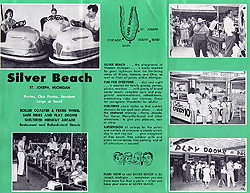 |
Page 3 of 6
1 | 2 | 4 | 5 | 6
Do you have any Silver Beach
Amusement Park photos, movies
or artifacts you'd like to share?
Please contact us.
1 Interview with Al Albright & Roberta Drake Terrill, January 1976. [ Back ] 2 Interview with Al Albright, January 1976. [ Back ] 3 Interview with Roberta Drake Terrill, April 1976. [ Back ] 4 All information concerning bathing beauty contests are from the Benton Harbor News Palladium, September 2, 1924. [ Back ] 5 Benton Harbor News Palladium, August 6, 1925. [ Back ] 6 Interview with Horace "Chief" Terrill, December 1975. [ Back ] 7 Interview with Roberta Drake Terrill, February 1976. [ Back ]
We credit Alan Schultz, Jeff Terrill, John Wenzlaff, Dennis Burlingham & Michigan History Magazine for the materials necessary to create this chapter in SW Michigan History.
To subscribe, click Michigan History Magazine.
|